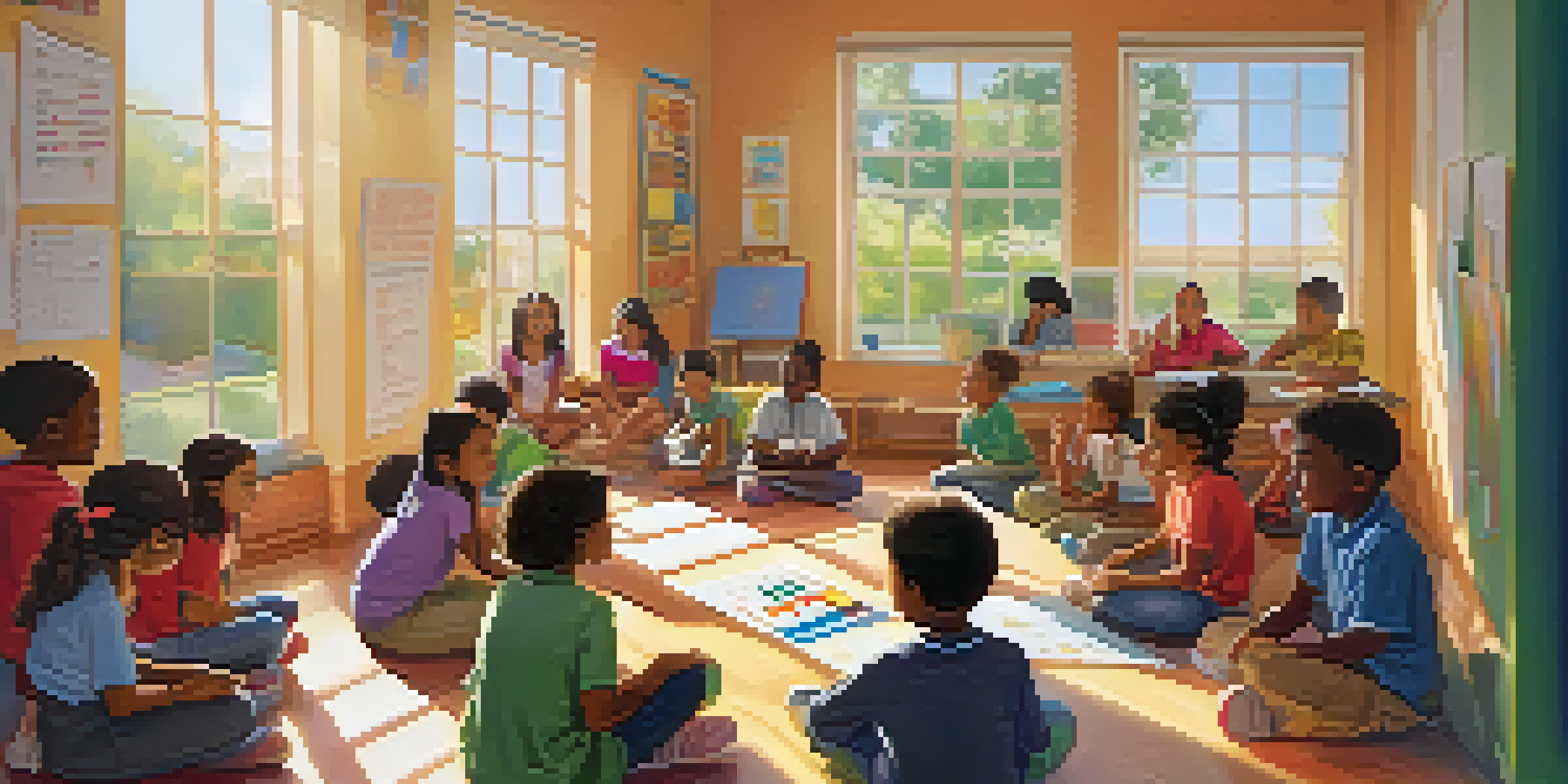Educating for Peace: Global Strategies and Implementations

Understanding the Concept of Peace Education
Peace education is more than just the absence of conflict; it encompasses teaching values, attitudes, and behaviors that foster harmony. By integrating principles of peace into education, we can cultivate a generation that values understanding and cooperation. This approach not only addresses conflict resolution but also promotes social justice and human rights.
Peace cannot be kept by force; it can only be achieved by understanding.
In classrooms worldwide, peace education encourages critical thinking and empathy among students. It helps them understand diverse perspectives and the importance of dialogue in resolving disagreements. Imagine teaching children the importance of listening to one another, much like how one might learn to appreciate different flavors in a shared meal.
Ultimately, peace education aims to create a culture of peace that extends beyond school walls. It prepares students to become active participants in their communities, equipped with the skills to address societal challenges. As global citizens, they can contribute to a more just and peaceful world.
Global Strategies for Implementing Peace Education
Different countries have adopted various strategies to integrate peace education into their curricula. For instance, Finland's education system emphasizes collaboration and open dialogue, showcasing how these principles can lead to a peaceful learning environment. This method contrasts sharply with traditional rote learning, highlighting the importance of fostering interpersonal connections.

In addition to formal education, many organizations are working to promote peace education through community programs. Initiatives like the Global Campaign for Peace Education provide resources and support to educators worldwide. This collaborative effort ensures that peace education is accessible, relevant, and tailored to local contexts.
Peace Education Fosters Harmony
By teaching values and conflict resolution, peace education promotes understanding and cooperation among students.
Moreover, technology plays a crucial role in expanding the reach of peace education. Online platforms and social media allow educators to share resources and best practices globally. This interconnectedness creates a supportive network that empowers teachers and students alike in their peace-building efforts.
Challenges in Implementing Peace Education
Implementing peace education is not without its challenges. In many regions, political instability and violence hinder educational efforts. Teachers may face resistance from parents or authorities who view peace education as a threat to their cultural or political beliefs.
Education is the most powerful weapon which you can use to change the world.
Furthermore, a lack of training and resources can limit the effectiveness of peace education programs. Educators may not feel equipped to handle sensitive topics like conflict and discrimination. Imagine a teacher trying to guide discussions on these issues without proper support—it's a daunting task that can discourage even the most passionate educators.
Despite these obstacles, many advocates remain dedicated to promoting peace education. They work tirelessly to develop training programs and resources that empower teachers to address these challenges head-on. By equipping educators with the necessary tools, we can begin to see a shift in attitudes towards peace education.
Case Studies of Successful Peace Education Programs
Several successful peace education programs provide valuable insights into effective strategies. One notable example is the 'Seeds of Peace' program, which brings together youth from conflict-ridden areas for dialogue and collaboration. By fostering relationships among participants, the program helps break down barriers and build understanding.
Another inspiring case is the 'Peace Builders' program in the Philippines, which focuses on conflict resolution and community building. This program not only teaches students essential skills but also encourages them to take leadership roles in their communities. Think of it as planting seeds of change that can grow into a more harmonious society.
Teachers as Peace Ambassadors
Educators play a crucial role in peace education by facilitating dialogue and modeling conflict resolution skills.
These case studies demonstrate that with the right approach, peace education can have a profound impact. They serve as powerful reminders that fostering peace is not just an ideal but a practical goal that can be achieved through dedication and collaboration.
The Role of Teachers in Peace Education
Teachers play a pivotal role in the success of peace education initiatives. They are not just conveyors of knowledge; they are facilitators of dialogue and understanding. By creating a safe space for students to express their thoughts and feelings, teachers can nurture empathy and respect among diverse groups.
Moreover, teachers can model peaceful conflict resolution in their classrooms. When disagreements arise, showing students how to navigate these situations constructively can empower them to apply these skills outside of school. Picture a classroom where students resolve conflicts through discussion rather than hostility—this is the essence of peace education.
In this way, teachers become ambassadors for peace, inspiring their students to carry these values into their communities. The influence of a dedicated educator can extend far beyond the classroom, creating ripples of positive change in society.
The Impact of Peace Education on Society
The benefits of peace education extend beyond individual students; they can transform entire communities. Educated individuals who value peace are more likely to engage in civic activities, advocate for social justice, and contribute to community well-being. This collective effort fosters an environment where conflict is addressed through dialogue rather than violence.
Numerous studies show that societies with strong peace education programs experience lower rates of violence and conflict. When individuals are equipped with conflict resolution skills and an appreciation for diversity, the likelihood of misunderstandings and disputes diminishes. Imagine a community where cooperation and understanding are the norms—this is the power of peace education.
Impact on Communities and Society
Effective peace education leads to lower violence rates and fosters a culture of dialogue and civic engagement in communities.
As these values take root, they can create a more inclusive and harmonious society. Peace education lays the groundwork for future generations to build upon, ensuring that the lessons of empathy and cooperation are passed down. Ultimately, this investment in education pays dividends in the form of lasting societal change.
The Future of Peace Education: Trends and Opportunities
Looking ahead, the future of peace education is filled with opportunities for innovation and growth. As awareness of global issues increases, educators are seeking new ways to engage students in meaningful discussions about peace. This includes integrating technology and experiential learning to create immersive educational experiences.
Furthermore, the rise of global citizenship education emphasizes the importance of understanding interconnectedness in today’s world. By fostering a sense of global responsibility, peace education can prepare students to tackle pressing issues such as climate change and inequality. Imagine students viewing themselves as part of a global community, working together for a brighter future.

As we embrace these trends, it's crucial to continue advocating for peace education at all levels. Policymakers, educators, and communities must collaborate to ensure that peace education remains a priority. By doing so, we can create a more peaceful world for generations to come.